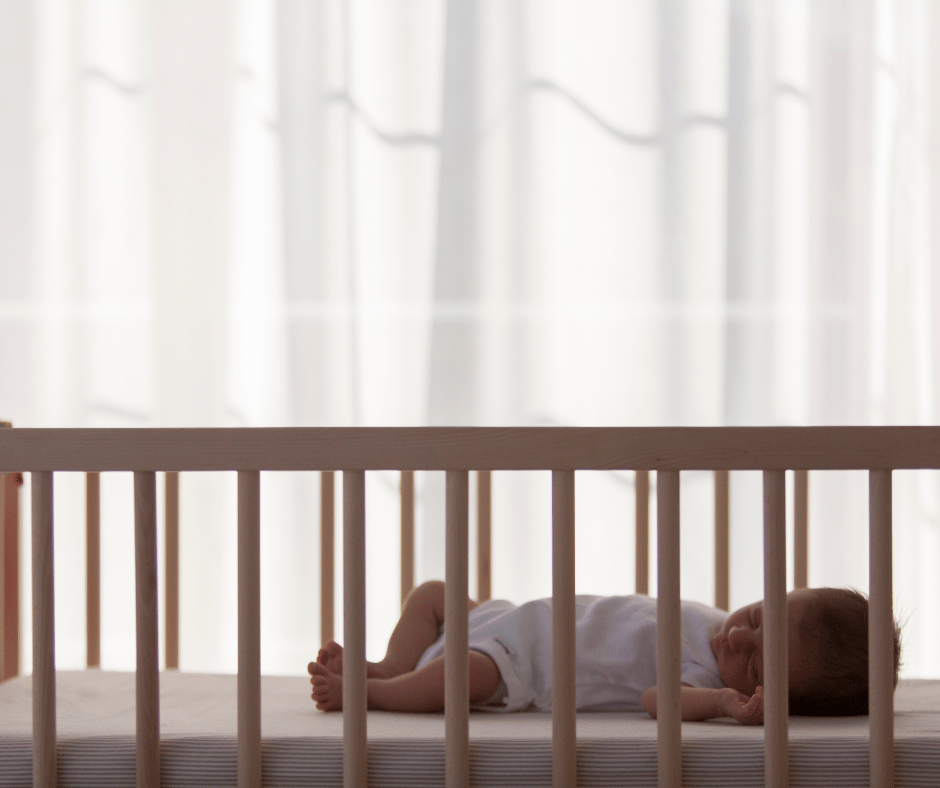Ready to sleep better tonight? Here are my Top 5 Tips for helping your little one sleep better!
A Guide to Daycare Sleep Routines

The importance of a naptime routine for babies in daycare
A naptime routine is essential for babies in daycare, as it helps them feel secure and comfortable in their new environment. A consistent sleep routine also promotes healthy sleep habits, which are crucial for their overall development.
When babies have a regular naptime routine, they learn to associate certain cues with sleep, making it easier for them to settle down and fall asleep. This is particularly important in a daycare setting, where there may be other children and distractions. By establishing a naptime routine, you can help your baby feel calm and secure, making their daycare experience more enjoyable.
Benefits of a consistent sleep routine for babies
A consistent sleep routine offers numerous benefits for babies in daycare. Firstly, it helps regulate their internal body clock, so they know when it’s time to sleep and wake up. This can lead to more predictable nap times, making it easier for daycare providers to plan activities and meals around your baby’s schedule.
Secondly, a consistent sleep routine promotes better sleep quality. When babies have a regular bedtime and naptime routine, their bodies become accustomed to falling asleep and staying asleep for longer periods. This allows them to get the restorative sleep they need to support their growth and development.
Lastly, a consistent sleep routine contributes to emotional well-being. Babies thrive on predictability and routine, and having a structured naptime routine can help them feel secure and content. It provides them with a sense of familiarity and reassurance, even in a new environment like daycare.
Understanding the sleep needs of babies in daycare
Before creating a naptime routine for your baby in daycare, it’s important to understand their sleep needs. The amount of sleep required varies depending on their age. Newborns typically sleep for 14-17 hours a day, while infants aged 4-12 months need around 12-16 hours of sleep. Toddlers, on the other hand, require about 11-14 hours of sleep, including both nighttime sleep and daytime naps. Download an example of total sleep needs per day for different age groups on my website.
It’s also important to consider your baby’s individual sleep patterns and preferences. Some babies may be natural “cat-nappers,” preferring shorter, more frequent naps, while others may need longer, consolidated periods of sleep. By observing your baby’s sleep patterns at home, you can gain insights into their sleep needs and tailor their daycare naptime routine accordingly.
Creating a naptime schedule for babies in daycare

When creating a naptime schedule for your baby in daycare, it’s essential to align it with their natural sleep patterns. Start by determining their optimal wake-up time. From there, you can calculate the ideal times for their naps based on their age and individual sleep needs.
It’s crucial to work closely with your daycare provider to ensure the schedule is feasible and can be implemented consistently.
Remember that flexibility is key, as babies’ sleep needs can change over time. Be prepared to adjust the naptime schedule as your baby grows and their sleep patterns evolve. Communicate any changes with your daycare provider, so they can make the necessary adjustments to ensure your baby’s sleep routine is maintained.
Transitioning from maternity leave to daycare sleep routines
Transitioning from maternity leave to a daycare sleep routine can be challenging for both parents and babies. However, with careful planning and preparation, you can help ease the transition and ensure a smooth adjustment to the new sleep routine.
Start by gradually introducing the daycare naptime routine a few weeks before your return to work. This will give your baby time to become familiar with the new schedule and sleep environment. Begin by implementing the routine during one or two naps at home, gradually increasing the number of naps following the daycare schedule.
To further support the transition, try to maintain a consistent bedtime routine at home. This will help create a sense of continuity and familiarity for your baby, even though their daytime sleep routine has changed.
Tips for establishing a naptime routine at daycare
Establishing a blissful naptime routine at daycare requires collaboration between parents and daycare providers. Here are some tips to help you create a positive sleep environment for your baby:
- Communicate openly: Share your baby’s sleep preferences, naptime routine, and any specific sleep cues with your daycare provider. Open communication ensures everyone is on the same page and can support your baby’s sleep needs effectively.
- Provide comfort items: Pack familiar items from home, such as a soft blanket or a favorite stuffed animal, to help your baby feel secure and comfortable during naptime at daycare.
- Create a sleep-friendly environment: Work with your daycare provider to ensure the sleep environment is conducive to restful sleep. Consider factors such as lighting, noise levels, and temperature. If necessary, provide blackout curtains or a white noise machine to create a soothing atmosphere.
- Maintain consistency: Aim to keep the naptime routine as consistent as possible between daycare and home. This helps your baby feel secure and promotes better sleep.
- Establish a transition routine: Help your baby transition from playtime to naptime by incorporating a soothing transition routine. This could include reading a book or singing a lullaby before settling them down for sleep.
By implementing these tips, you can create a blissful naptime routine at daycare, ensuring your baby gets the restful sleep they need for their well-being and development.
Common challenges and solutions for daycare sleep routines
While establishing a daycare sleep routine, you may encounter common challenges. Here are some solutions to address these challenges effectively:
- Separation anxiety: Some babies may experience separation anxiety when transitioning to daycare. To ease their anxiety, establish a consistent drop-off routine and reassure them that you will return.
- Napping in a new environment: Babies may find it challenging to nap in a new environment. To help them adjust, provide comfort items from home and work with your daycare provider to create a sleep-friendly space.
- Changing nap patterns: As your baby grows, their nap patterns may change. Stay flexible and adjust the naptime schedule accordingly, ensuring your baby’s sleep needs are met.
- Distractions: Daycare settings can be noisy and stimulating, making it difficult for babies to fall asleep. Collaborate with your daycare provider to minimize distractions during naptime, such as separating napping areas from active play areas.
By establishing clear lines of communication and maintaining ongoing dialogue with your daycare provider, you can ensure your baby’s sleep routine is effectively communicated and followed.
Remember, every baby is unique, and what works for one may not work for another. Trust your instincts as a parent, and don’t hesitate to seek professional advice if needed.
Creating a naptime routine for your baby in daycare is crucial for their well-being and development. By understanding the importance of a consistent sleep routine, recognizing your baby’s sleep needs, and effectively communicating with daycare providers, you can establish a routine that promotes healthy sleep habits and makes your baby’s daycare experience more enjoyable. Remember to remain flexible, observe your baby’s individual sleep patterns, and make adjustments as needed. With a little planning and preparation, you can create a nurturing sleep environment that supports your baby’s growth and happiness.
If you need some guidance on your little ones’ daycare routine, schedule a call with me so we can see how I can help you. I am a Pediatric Sleep Consultant, with over 10 years’ experience working with children, and helping parents every day with sleep challenges.


